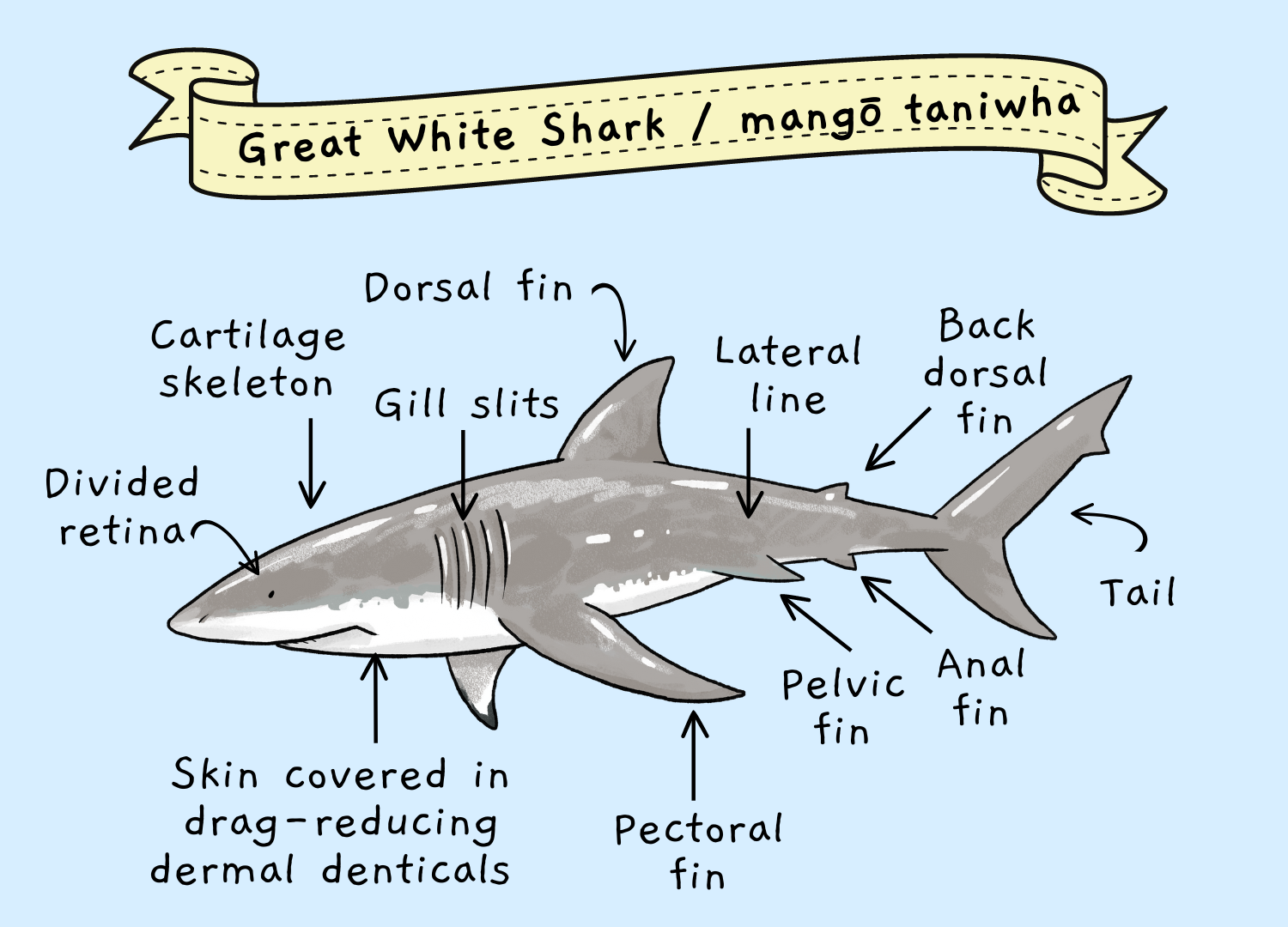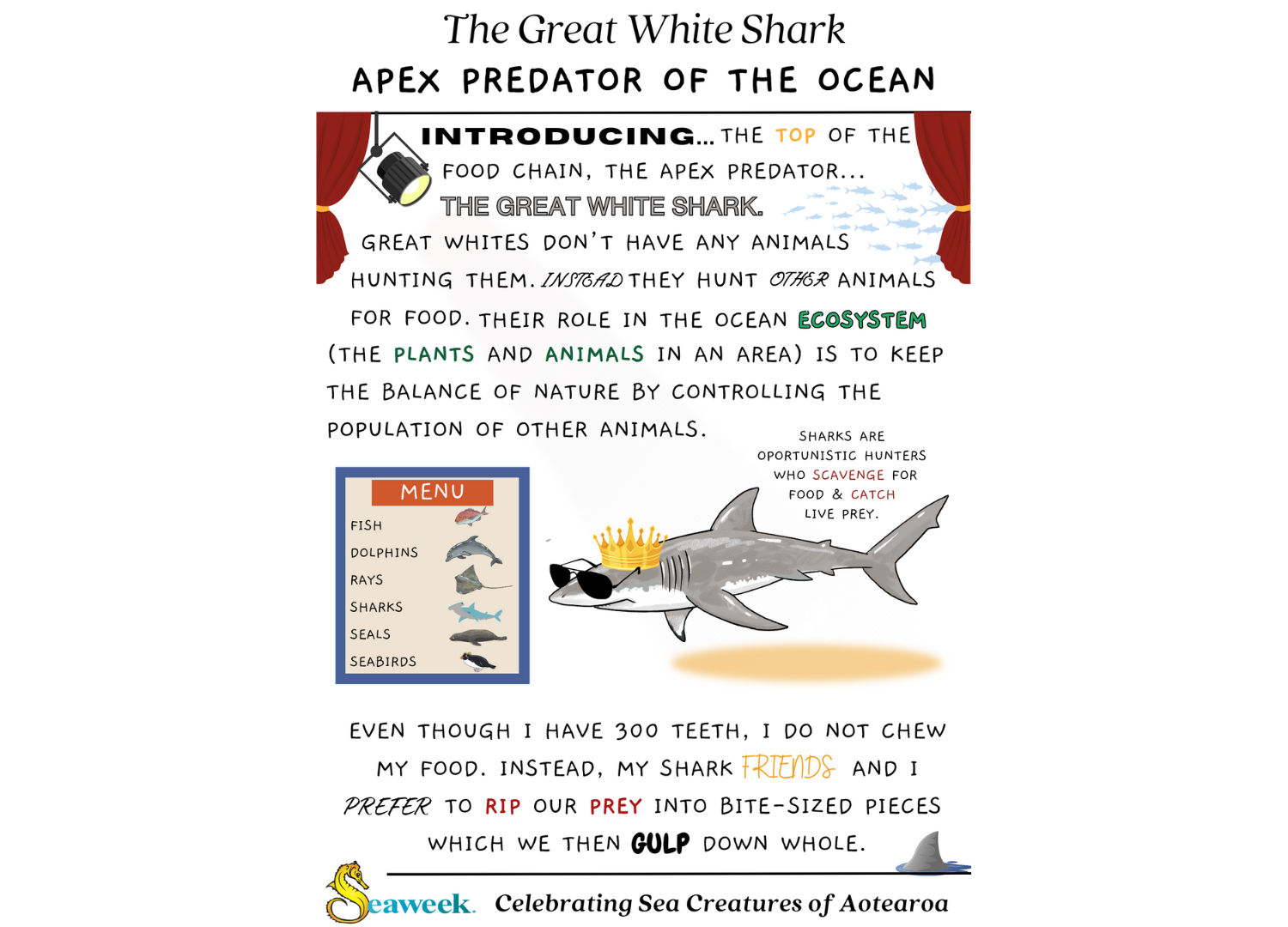
Q. Kia ora Ms. Great White Shark! Can you tell us a little about yourself?
A. I am one of New Zealand’s largest apex predators - the Great White Shark! Lady Great Whites can grow as long as half a bus (7 meters)! In Te Reo Maōri I am known as mangō taniwha. Mangō means shark and taniwha is what they call the mythical monster - they must have looked at my ancestors and thought we were taniwha!
Q. Where do you like to hang out?
A. I tend to keep a low profile around humans, but you can spot me around the country, particularly near seal colonies, and especially during the summertime. New Zealand’s temperate waters are pretty ideal for great white sharks, some of which migrate between New Zealand and Australia and even tropical countries.
Q. How do you travel such long distances?
A. During migration, I use the Earth’s magnetic field to navigate in a straight line over long distances. I have a streamlined body and skin covered with drag-reducing structures, known as dermal denticles, which are like teeth covering my skin. Having dermal denticles allows me to swim up to 40-50 km per hour.
Q. What is your favourite food?
A. I am at the top of the food chain, an apex predator, meaning that great whites don’t have any animals hunting us. Instead, we hunt other animals for food. My role in the ocean ecosystem is to keep the balance of nature by controlling the population of other animals. My daily menu consists of a selection of a variety of species, including fishes, sharks, rays, seabirds, seals, and dolphins. I am an opportunistic hunter who scavenges for food and catches live prey. Even though I have 300 teeth, I do not chew my food. Instead, my shark friends and I prefer to rip our prey into mouth-sized pieces which we then gulp down whole.
Q. What makes you such an effective predator?
A. My powerful sense of smell, lateral lines, allowing me to detect movement up to 250m away, and electroreception, which detects electrical currents of other animals, helps me to quickly locate prey. I also have a divided retina, allowing me to spot prey in daylight and low-light conditions. My skeleton is made up of cartilage - the same thing which makes up your nose and ears! Cartilage is much less dense than bones, allowing me and my shark friends to move through the water at a fast pace without using too much energy.

Q. Where are baby sharks born?
A. I pup my babies in shallow estuaries, where they can grow up protected from larger predators, and with ample small prey like octopus, crabs, rays and fish. As a mumma shark, I can have up to six babies every three years - they come out at 1.5m long! My babies have 400 million years of instinct built into their brains, so we don't actually have to provide any motherly care. Recently, Dr. Riley Elliott identified one of my nursery areas in the Tauranga harbour and with the help of the NZ public, small satellite tags were attached to baby sharks so people could learn more about their favourite spots to hang out. Also to show how sometimes, very sadly, they get caught in nets and fishing lines. By tagging young white sharks, people will learn more about how to protect them so they can grow big and strong and carry on the important ocean role as apex predators.
Q. What are the threats you face?
A. As large and powerful predators, we play an important role at the top of the marine food chain. However, we are classified as Vulnerable globally by the International Union for Conservation of Nature (IUCN) Red List of Threatened Species which means I face some serious threats. From getting caught accidentally by fishermen to becoming entangled and hunted, life can be tough. Our ability to recover from our population loss is also limited by the low reproductive rate of Great White Sharks. Our populations are indirectly affected by the decline in numbers of key prey species because of changes in coastal productivity, pollution, and habitat loss.
Thanks Riley Elliot for reviewing our 'interview' and offering some info on where white shark babies are born!

View the Great White Shark 'Creature Card' PDF
These creature cards are designed to download, print & display with your poster. Find a format to suit your needs in this Google Drive folder.
Check out our 'Hungry Hunters' GWS Craft Sheet
-1709701350-COPY.png)
Learning Resources:
- Young Ocean Explorers 'Are shark bones made from noses?' video: youngoceanexplorers.com
- Young Ocean Explorers 'Is shark skin made from teeth?' video: youngoceanexplorers.com
- Young Ocean Explorers 'Learn to draw a Great White' video: youngoceanexplorers.com
- Great White Shark App; showing positions of some tagged sharks: sustainableoceansociety.co.nz
.png)
Visit these sites to learn more:
- NIWA Great White Shark tagging: niwa.co.nz/oceans/research-projects/white-sharks
- Sustainable Ocean Society tracking GWS in North Eastern NZ: sustainableoceansociety.co.nz/projects/shark-conservation
- DOC White Shark article: doc.govt.nz/nature/native-animals/marine-fish-and-reptiles/sharks-mango/white-shark
- Shark navigation article: science.org/content/article/sharks-use-earth-s-magnetic-field-navigate-seas
- Shark anatomy article: fieldmuseum.org/blog/what-makes-shark-shark